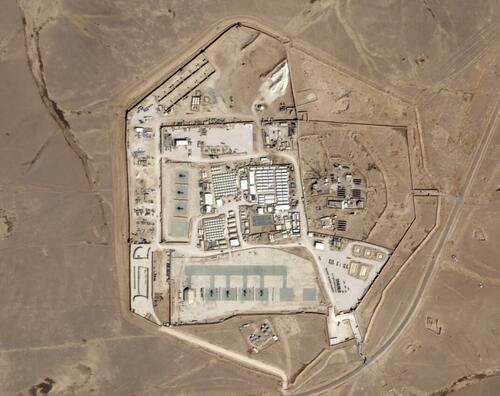
The United States government would have you believe the military base in Jordan where three soldiers were killed in a drone strike is a mere "logistics support base." In truth, the facility also serves as a base for US drones used to conduct reconnaissance and target identification in Syria and Iraq, according to a report from The Intercept's Ken Klippenstein.
The base in Jordan, which is called Tower 22, is positioned just six miles from the Syrian border, and close to the Al-Tanf base where US servicemembers are based inside Syria. After a Jan. 28 drone attack on Tower 22 killed three soldiers and wounded dozens more, US Central Command described the facility as a "logistics support base" housing some 350 Army and Air Force personnel.

However, an Air Force airman who was recently stationed at Tower 22 tells The Intercept there's much more to the base than managing supplies:
“To call Tower 22 a logistics support base is complete bullshit. The main purpose of Tower 22 is to operate drones to spy on insurgents in Iraq and Syria, for targeting purposes. The main objective I witnessed was taking out targets.”
According to the airman, intelligence collected in Tower 22's drone operations is used by USAF units at other bases, including Jordan's Muwaffaq Salti Air Base, to carry out airstrikes in the region.

CENTCOM says the base is used to give "support to the coalition for the lasting defeat of ISIS." The claimed ISIS mission is central to the legal justification for the continued US military presence in Syria, which relies on an expansive interpretation of Congress's 2001 authorization to use military force (AUMF) against terrorists and others who facilitated the 9/11 attacks.
However, that's all a pretense: The principal purpose of US operations in Iraq and Syria is to limit Iranian influence in the region, to include countering Iranian-allied militant groups, while also weakening the Syrian government by depriving it of access to its own oil fields.
"Whatever they’re doing there, there’s very little evidence that it’s counter-ISIS,” State Department veteran and International Crisis Group senior adviser Brian Finucane tells The Intercept. “The counter-ISIS mission is the only legal basis there is for the U.S. to be there. There’s no legal basis to have U.S. troops in Syria to be countering Iran.”
In December, the Senate overwhelmingly rejected a bill proposed by Sen. Rand Paul that would have asserted that the 2001 AUMF does not apply to Syria. Said Paul at the time:
“It seems to me, though our 900 troops have no viable mission in Syria, that they’re sitting ducks. They’re a tripwire to a larger war, and without a clear-cut mission, I don’t think they can adequately defend themselves, yet they remain in Syria.”

While Tower 22 is just across the border from Syria, Paul's words proved all too prescient for those killed and wounded at the base on Jan. 28. In an earlier Intercept report, an airman previously stationed at the base -- perhaps the same one quoted in the latest story -- said, "The air defenses were minimal, if any...We had a radar system called TPS-75 that was broken 80 percent of the time I was there.”
The sitting ducks at Tower 22 paid a steep price for their decision to enlist, and for their government's unrelenting support of Israel, to include the ongoing, massively destructive campaign in Gaza. When claiming responsibility for the attack on Tower 22, a senior official in a coalition of Iraqi militias said, “As we said before, if the U.S. keeps supporting Israel, there will [be] escalations. All the U.S. interests in the region are legitimate targets, and we don’t care about U.S. threats to respond.”
The United States government would have you believe the military base in Jordan where three soldiers were killed in a drone strike is a mere “logistics support base.” In truth, the facility also serves as a base for US drones used to conduct reconnaissance and target identification in Syria and Iraq, according to a report from The Intercept‘s Ken Klippenstein.
The base in Jordan, which is called Tower 22, is positioned just six miles from the Syrian border, and close to the Al-Tanf base where US servicemembers are based inside Syria. After a Jan. 28 drone attack on Tower 22 killed three soldiers and wounded dozens more, US Central Command described the facility as a “logistics support base” housing some 350 Army and Air Force personnel.

However, an Air Force airman who was recently stationed at Tower 22 tells The Intercept there’s much more to the base than managing supplies:
“To call Tower 22 a logistics support base is complete bullshit. The main purpose of Tower 22 is to operate drones to spy on insurgents in Iraq and Syria, for targeting purposes. The main objective I witnessed was taking out targets.”
According to the airman, intelligence collected in Tower 22’s drone operations is used by USAF units at other bases, including Jordan’s Muwaffaq Salti Air Base, to carry out airstrikes in the region.

CENTCOM says the base is used to give “support to the coalition for the lasting defeat of ISIS.” The claimed ISIS mission is central to the legal justification for the continued US military presence in Syria, which relies on an expansive interpretation of Congress’s 2001 authorization to use military force (AUMF) against terrorists and others who facilitated the 9/11 attacks.
However, that’s all a pretense: The principal purpose of US operations in Iraq and Syria is to limit Iranian influence in the region, to include countering Iranian-allied militant groups, while also weakening the Syrian government by depriving it of access to its own oil fields.
“Whatever they’re doing there, there’s very little evidence that it’s counter-ISIS,” State Department veteran and International Crisis Group senior adviser Brian Finucane tells The Intercept. “The counter-ISIS mission is the only legal basis there is for the U.S. to be there. There’s no legal basis to have U.S. troops in Syria to be countering Iran.”
In December, the Senate overwhelmingly rejected a bill proposed by Sen. Rand Paul that would have asserted that the 2001 AUMF does not apply to Syria. Said Paul at the time:
“It seems to me, though our 900 troops have no viable mission in Syria, that they’re sitting ducks. They’re a tripwire to a larger war, and without a clear-cut mission, I don’t think they can adequately defend themselves, yet they remain in Syria.”

While Tower 22 is just across the border from Syria, Paul’s words proved all too prescient for those killed and wounded at the base on Jan. 28. In an earlier Intercept report, an airman previously stationed at the base — perhaps the same one quoted in the latest story — said, “The air defenses were minimal, if any…We had a radar system called TPS-75 that was broken 80 percent of the time I was there.”
The sitting ducks at Tower 22 paid a steep price for their decision to enlist, and for their government’s unrelenting support of Israel, to include the ongoing, massively destructive campaign in Gaza. When claiming responsibility for the attack on Tower 22, a senior official in a coalition of Iraqi militias said, “As we said before, if the U.S. keeps supporting Israel, there will [be] escalations. All the U.S. interests in the region are legitimate targets, and we don’t care about U.S. threats to respond.”
Loading…





